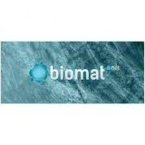Theme: Exploring Novel Methods in Nanomedicine
Renowned Speakers
NANOMED CONGRESS 2022
International Summit on Nano medicine and Robotics 2022. Takes immense pleasure in greeting all the participants from across the globe to attend International Summit on Nano medicine and Robotics during October 18-19, 2022 Webinar. Their keynote presentations, verbal speeches, useful poster presentations and exhibitions along with a discussion forum providing the insights on the advances of the nanotechnology. Nano medicine and Robotics is an International gathering that unites all the modernizers to glaze the entire field of Nanotechnology and to experience the advancements in the research and development in the field of Nanotechnology and Nano medicine. The new developing prosthesis with applied technologies of Bio materials, Nanotechnology, Robotics and Tissue engineering in Nano fields are comprised in the conference. This the advancements in the field of Nano medicine and Robotics to expose their research work across the global.
Target Audience:
Nano Medicine and Robotics Researchers
Nano Medicine and Robotics Academies
Nano Medicine and Robotics Associations and Societies
Business Entrepreneurs
Global Nano Medicine and Robotics organizations
Nano medicine and Robotics Investors
International Summit on Nano medicine and Nanotechnology in Health care takes immense pleasure in greeting all the participants from across the globe to attend International Summit on Nano medicine and Nanotechnology in Health care during May 11-12, 2023San Francisco, USA. Their keynote presentations, verbal speeches, useful poster presentations and exhibitions along with a discussion forum providing the insights on the advances of the nanotechnology. Nano medicine and Robotics is an International gathering that unites all the modernizers to glaze the entire field of Nanotechnology and to experience the advancements in the research and development in the field of Nanotechnology and Nano medicine. The new developing prosthesis with applied technologies of Bio materials, Nanotechnology, Robotics and Tissue engineering in Nano fields are comprised in the conference. This the advancements in the field of Nano medicine and Robotics to expose their research work across the global.
Target Audience:
-
Nano Medicine and Nanotechnology Researchers
-
Nano Medicine and Nanotechnology Academies
-
Nano Medicine and Nanotechnology Associations and Societies
-
Business Entrepreneurs
-
Global Nano Medicine and Nanotechnology organizations
- Nano medicine and Nanotechnology Investors
TRACK 1: Nanotechnology
Nanotechnology contracts with materials and systems whose structures and components have advanced and significant features improved Physical, Chemical and Biological properties, processes and phenomena due to their Nano scale size.
It shows high proficiency in ending Cancer cells. Nano medicines also include Nano adjuvants with immune modulatory assets used to deliver vaccine antigens, Nano-knife, an almost non-invasive method of abolishing cancer cells with high voltage electricity and carbon nanotubes, which they already a popular way to repair smashed tissue and could be used to regenerate nerves in the futu
TRACK 2: Nano Devices
Nano devices are incorporated into microcircuits or Nano circuits and provide for robust technologies. In the physics of Nano scale devices, the perfection of the evolution from microelectronics to Nano electronics was emphasized by the merging of quantum mechanical physics and the quasi classical electronic circuit theory. Nano devices are basically molecules with a purpose and have both simple and complex functions. Nano refers to characterization of parts measured in Nano-meters. Nano devices can be designed by computer software, such as MATLAB® and Nano explorer. Nano explorer works with collections of different hierarchical components, Nano systems, connections, molecular devices, and interfaces to develop Nano devices. There are two types of Nano device manufacturing processes: molding/etching materials to smaller components and Atom-by-atom assembly of structures. In the broadest sense, Nano devices allow researchers to exploit .The best examples of Nano devices are at present clearly associated with Internet of things (IOT) industries, where the potential for such devices is much broader due to the use of Nano battery systems that can extend the life span of an IOT device.
TRACK 3: Bioengineering
Bio Engineering is the application of the life sciences, physical sciences, mathematics and engineering principles to define and solve problems in biology, medicine, health care and other fields.
Bio engineering is a relatively new Discipline that combines many aspects of traditional engineering fields such as chemical, electrical and mechanical engineering. Examples of bio engineering include: artificial hips, knees and other joints ultrasound, MRI and other medical imaging techniques using engineered Organisms for chemical and pharmaceutical manufacturing Bio engineering graduates are employed by a variety of institutions, including medical device manufacturers, pharmaceutical companies, regulatory agencies and medical research Institutions. In addition, bio engineering graduates are prepared for continued study to pursue careers in medicine, law, business and other fields.
TRACK 4: Nano Fabrics
Nano Fabrics are textiles Engineered with small particles that give ordinary materials advantageous properties such as super hydrophobic (extreme water resistance, also see "Lotus effect"),odor and moisture elimination, increased elasticity and strength, and bacterial resistance. Depending on the desired property, a Nano fabric is either constructed from Nano osmic fibers called Nano fibers, or is formed by applying a solution containing Nano-particles to a regular fabric. Molecular Chemistry, Physics, Electrical Engineering, Computer Science, and systems engineering. Nano-fibers possess multi-functional properties such as good Filtration, high surface area, high permeability, small Fiber Diameter, and thin Layers.
TRACK 5: Biopolymers
Bio-polymers consist of Monomeric units that are covalently bonded to form larger molecules. There are three main classes of bio-polymers, classified according to the monomers used and the structure of the bio-polymer formed: Polynucleotides, such as RNA and DNA, are long Polymers composed of 13 or more [clarification needed] nucleotide monomers. Examples of bio-polymers include natural rubbers (polymers of isoprene), sabering and lignin (complex polyphonic polymers), cutin and cutan (complex polymers of long-chain fatty acids) and melanin. Bio-polymers have applications in many fields including the food Industry, manufacturing, packaging, and biomedical engineering.
TRACK 6: Human-Robot Interaction
Humans have a Tendency to "personify" computers, according to early research in human-robot interaction (HRI). When Schreiber and Erwin's subjects played a simple strategy game with a computer, they used personal and were quite emotionally interested. The divergence between normative, rational contact with the computer and the particular socioemotional responses of the human user was demonstrated by this conduct, which was unrelated to real game performance.
The CASA theory proposes that humans apply the same norms and Heuristics when interacting with computers as they do with humans, and that human actors are unaware of their conduct toward computers because they are "mindless." A lot of research has backed up the assumptions of CASA by using social psychology theory and empirical tests. Certain prejudices that were believed to apply only to humans were applied in interactions with computers in student samples, for example. When engaging with a computer with a male, female, or neutral voice, Participants in one study displayed stereotypic gender behavior. Participants in another study were shown movies of people of either the same or different races.
Improving how humans and robots collaborate can aid in the democratization of robotics. Robots will be able to adapt to new human users more easily, regardless of their skill, thanks to techniques like imitation learning, artificial intelligence, and computer modelling – even as the robots adapt to new tasks, situations, and surroundings. The correct interface can put the power of robotics in the hands of everyday people, whether it's a factory supervisor who needs a product adjustment or a homebound stroke survivor who uses a drone to inspect his garden and rooftop solar panels.
TRACK 7: Robotic Technology
New Inventions are broadening the scope of technological advancements. Robots are one such invention that has helped to tackle the ever-present problem of rising labor costs. It is an interdisciplinary field that encompasses mechanical, electrical, electronic, and Computer science design. At this time, robots assist humans in a variety of industries, such as making life more trustworthy and delivering goods faster than humans. This paper provides an overview of robotics technology, science, and systems. We discuss the history of Robotics technology, science, and systems, as well as the construction of robots and the components utilized in their manufacture, as well as the benefits, drawbacks, and uses of robotics technology. We included the following in this paper:
We included robotics Technology in this study since, in the current scenario, robot vision systems are primarily utilized for inspection purposes in sectors such as gauging, verifying the presence of components, detecting faults, and so on. In this study, we provide a quick overview of robotics' future applications in daily life, including both home and business applications. The primary goal of our study is to raise public Awareness about advances in robotics technology that benefit people such as businesspeople, ordinary people, scientists, doctors, and engineers.
TRACK 8: Micro and Nano Robots
The first generation of Small-Scale robots are generally referred to as "micro/Nano motors" or "micro/Nano engines" by researchers in the micro/nanorobotics field, which are described as small scale devices capable of converting a variety of energy sources into locomotion or actuation. A micro/Nano robot, on the other hand, is a small scale device capable of mechanical actuation to fulfil a preprogrammed task. It's been difficult to define what constitutes a micro/Nano robot because small-scale robotic designs differ significantly from their macroscale equivalents. When a new study subfield emerges from an established topic, its success is usually measured in terms of what it isn't rather than what it is. Automobiles, for example, were dubbed "horseless carriages" when they first appeared on the streets more than a century ago. When compared to internal combustion engines, electric motors, or hydraulic and pneumatic systems, the design of tiny size robots presents unique obstacles. Viscous forces dominate inertial forces at tiny scales. Environmental influences such as Brownian motion, which is induced by random collisions of water molecules with microscale objects and interferes with the directionality of a motile micro/Nano robot, must be considered when designing structures at such a small scale.
TRACK9: Carbon nanotechnology
Nanotechnology is no longer only a topic of conversation; it is beginning to have an impact on everyone's lives. Carbon nanotechnology has evolved into a fully interdisciplinary field that includes chemistry, physics, biology, medicine, materials science, and Engineering as a primary shaper of new nanotechnologies. This is a field in which a significant amount of literature has been produced in recent years, and the number of articles continues to rise year after year. Carbon Nanotechnology seeks to give timely coverage of latest developments in the field, as well as updated assessments and comments from internationally renowned specialists. Carbon Nanotechnology is intended to be an exhibition of cutting-edge research and development rather than a conference proceeding. It will be highly valuable not only to experienced scientists and engineers, but also to those who are new to the field. who want to learn more about Nanotechnology and/or develop practical gadgets, as well as graduate and senior undergraduate students who want to make a name for themselves in this sector of the future.
TRACK10: Nano Pharmaceuticals
Nano Pharmaceuticals have the potential to detect illnesses at an earlier stage, and diagnostic submissions could build on existing nanoparticle-based treatments. The term "Nano pharmaceuticals" refers to a new discipline in which the dimensions of a drug particle or a Therapeutic delivery system are measured at the nanoscale. The effort of getting the appropriate dose of a certain active drug to a specific illness site is a long-standing concern in the pharmaceutical industry. Traditional therapies, which advise site-specific targeting of active drugs, have failed to solve this deficiency. Nano pharmaceuticals have immense potential in overcoming this failure. Nano pharmaceuticals' precise targeting decreases hazardous systemic side effects, resulting in improved patient compliance. In today's global economy, the pharmaceutical sector is under tremendous pressure to provide high-quality yields to patients while being profitable. As a result, pharmaceutical companies are developing new drugs.
Drug target detection and drug delivery can be improved or supplemented with nanotechnology. Nano pharmaceuticals reduce drug discovery, design, and development costs while also improving medication delivery. As a result, the success rate of research and development improves, allowing for the introduction of innovative, cost-effective products to the market sooner.
TRACK9: Nanotechnology Environmental Effects and Industrial Safety
As nanotechnology advances, so does the scope of its commercial application. Nanotechnology's vast advancement potential stems from the wide range of projected things and uses.The whole nanotechnology Sector is expected to generate US$ 75.8 billion by 2020, according to estimates. In such a situation, there is a massive open door for business people to tap into the fast growing business sector. Nano technological products, cycles, and Applications are expected to provide significant contributions to environmental and atmospheric security by conserving crude materials, energy, and water, as well as reducing ozone-depleting compounds and hazardous wastes. The use of Nanomaterials ensures certain natural benefits and implications on maintainability.
TRACK10: Nanoparticle
A nanoparticle, also known as an Ultrafine particle, is a small particle of matter with a dimension of 1 to 100 nanometers (nm). Larger particles (up to 500 nm) or fibers and tubes (less than 100 nm in just two directions) are sometimes referred to as nanoparticles. Metal particles less than 1 nm are commonly referred to as atom clusters instead. Nanoparticles are distinguished from micro particles (1-1000 m), "fine particles" (sized between 100 and 2500 nm), and "coarse particles" (sized between 2500 and 10,000 nm) by their smaller size, which leads to very different physical and Chemical properties, such as colloidal properties, ultrafast optical effects, and electric properties.
TRACK11: Nanorobotics
The introduction of molecular Nanotechnology will improve the efficiency, convenience, and speed of future healthcare while also lowering the danger, expense, and invasiveness. MNT will enable doctors to perform direct surgery on individual human cells in vivo. This will be Achieved thanks to the ability to design, develop, and deploy a huge number of micro-medical Nano robots. Because of their basic form and operation, Nano-Bearings and Nano-gears may be the easiest component category to develop.
Center for Biological and Environmental Nanotechnology, Integrated Scientific Center for Nanotechnology, Center for Characterization and Manufacturing of Nanostructures, Center for Social Nanotechnology, Advanced Institute of Quantum and Nanoscale Science and Technology (Nano STAR), Institute of Soldier Nanotechnology, Nanofabrication Plant, Advanced Institute of Quantum and Nanoscale Science and Technology (Nano STAR), Institute of Soldier Nanotechnology, Nanofabrication Plant
TRACK12: Impact of Nanomedicine on Health Care
Nanotechnology's application in Human social insurance has the potential to improve treatment decision and treatment, as well as restore tissues and organs. It has the potential to totally transform the sector of human services in the future. Nanotechnology will aid medical Professionals in solving today's most significant treatment issues, such as restoring damaged organs, completing and treating diseased cells, removing obstructions in the brain, and improving medication delivery frameworks. Nanotechnology can be employed in biomedical research and applications both in vivo and in vitro. Nanoparticles can be utilised to target cancer cells in their early stages. Nanotechnology can be utilised to create "signature proteins" that can be used to cure cancer.
Some of the linked societies include the American Chemical Society, Nanotechnology Security Resources, and the American Society of Precision Engineering (ASPE).
TRACK13: Nanotechnology & Energy
The majority of research into hydride materials for imperativeness applications concentrates on revamping the materials' gravimetric limit thickness and molecule movement. On the other hand, the requirements for stationary applications, such as power devices, can be quite diverse and applicable to a broader range of potential materials. Different geophysical and socioeconomic pressures are forcing a shift away from fossil fuels and toward more sustainable and useful essentiality sources. We should create materials that will promote fresh imperativeness pushes to affect this shift.The most important requirement for making helpful and profitable photovoltaic cells is the presence of the sun. Catalysts for fuel cells are being made cheaper via nanotechnology. These catalysts generate hydrogen ions from methanol as a fuel. Nanotechnology is also a growing field. Membranes used in fuel cells to separate hydrogen ions from other gases, such as oxygen, are being employed to improve their efficiency.
TRACK14: Nanotechnology and Nanomedicine
Nanotechnology is a branch of science, engineering, and technology that works on a scale of one to one hundred nanometers. Nanotechnology is concerned with materials and systems whose structures and components, because to their Nano scale size, have novel and significant physical, chemical, and biological properties, processes, and phenomena. It is the study and application of extremely small objects, which can be found in all science and engineering areas. It has a high rate of cancer cell destruction. Nano adjuvants with immune modulatory properties used to deliver vaccine antigens, Nano-knife, an almost non-invasive method of destroying cancer cells with high voltage electricity, and carbon nanotubes, which are already a popular way to repair damaged tissue and could be used to regenerate nerves in the future, are all examples of Nano medicines. future. Clinical trials with nanomedicine. Traditional medical practice is based on care guidelines derived from large cohort epidemiologic studies, which are not necessarily appropriate to a unique individual. As a result, while examining an individual patient, physicians typically take into account unique features such as age, gender, weight, food, and surroundings. They use diagnostic tests to learn more about the patient's disease and choose specific treatment options and drug dosages based on the results of those tests, as well as the patient's family medical history, comorbidities, and lifestyle factors, because they recognize that patients respond differently to treatments. However, it is only recently that research has begun to provide physicians with a molecular or genetic understanding of individual patient or illness distinctions, allowing them to make better decisions.
Nanotechnology is the advancement and engineering of devices that are so small that they can only be measured on a molecular level. People from a variety of disciplines, including physicists, chemists, engineers, and material researchers, as well as biologists, are involved in this emerging topic. Nanotechnology is being used in almost every discipline, including physics, magnetics, computer technology, materials development, and healthcare. Nanoparticles of metals and semiconductors, nanowires, Nano biological systems, and Nanotubes are just a few of the areas of concern in the Nanomedicine and nanotechnology industry that are expected to be investigated in the coming years
Importance and Scope:
Nanomedicine is a branch of nanotechnology that is used to diagnose, treat, monitor, and control biological systems. Nanomedicine will extend the shelf life of a medicament. the human body It's critical that cancer-fighting medications are specifically targeted to prevent harming healthy cells in the surrounding area. Nanomedicine's present applications are helping to improve drug delivery for therapy. Drugs that are eliminated from the body as waste before treatment can be effective can also be treated with nanomedicine. Nanomaterials can be employed in nanomedicine for medicinal purposes in three main areas: diagnostic (Nano diagnosis), controlled drug delivery (Nano treatment), and regenerative medication. Nanomedicine is likely to see more fascinating discoveries in medical research, engineering, chemistry, and physics in the next years. Researchers are working on medical applications such as illness prevention, diagnosis, and treatment, as well as pain relief. Nanotechnology will be the only science that matters. No other science can survive without it in the future. Nanotechnology has applications in a variety of sectors, including medicine, automobiles, and aeronautics, among others. As a result, the breadth is significantly broader.
Nanomedicine and nanotechnology research in different parts of the world:
From 2016 to 2023, the Nanomedicine market in Asia is expected to develop at the fastest rate of thirteen.4%. Nanomedicine is a brand-new and extremely promising technology in the twenty-first century. This is typically due to the fact that it aids in simple bar, diagnosis, treatment, and tissue and organ regeneration. Nanomedicine may be a cost-effective technology in the designated sector because it requires a little amount of biological material and hence uses fewer disposables and reagents.
Why to attend?
Nanomedicine and Robotics 2022 offers a wonderful prospect to meet the experts in the field of nanomedicine, by providing coopetition spaces. Conference permits the gives to encounter their issues addressed on nanomedicine by familiar global experts who are up-to-date with the recent technologies of nanomedicine. This nanomedicine and Robotics conference will aspect world renowned keynote speakers, plenary speeches, young research forum, poster presentation, technical workshops and career control sessions.
Conference Highlights
- Nanotechnology:
- Nano Devices:
- Bioengineering:
- Nano Fabrics:
- Biopolymers:
- Human-Robot Interaction:
- Robotic Technology:
- Micro and Nano Robots:
- Carbon nanotechnology:
- Nano Pharmaceuticals:
- Nanotechnology Environmental Effects and Industrial Safety:
- Nanoparticle:
- Nanorobotics:
- Impact of Nanomedicine on Health Care:
- Nanotechnology & Energy:
- Nanotechnology and Nanomedicine:
To share your views and research, please click here to register for the Conference.
To Collaborate Scientific Professionals around the World
| Conference Date | October 17-18, 2022 | ||
| Sponsors & Exhibitors |
|
||
| Speaker Opportunity Closed | |||
| Poster Opportunity Closed | Click Here to View | ||
Useful Links
Special Issues
All accepted abstracts will be published in respective Our International Journals.
Abstracts will be provided with Digital Object Identifier by














